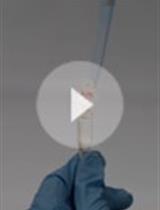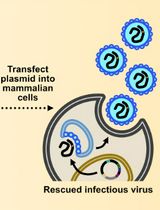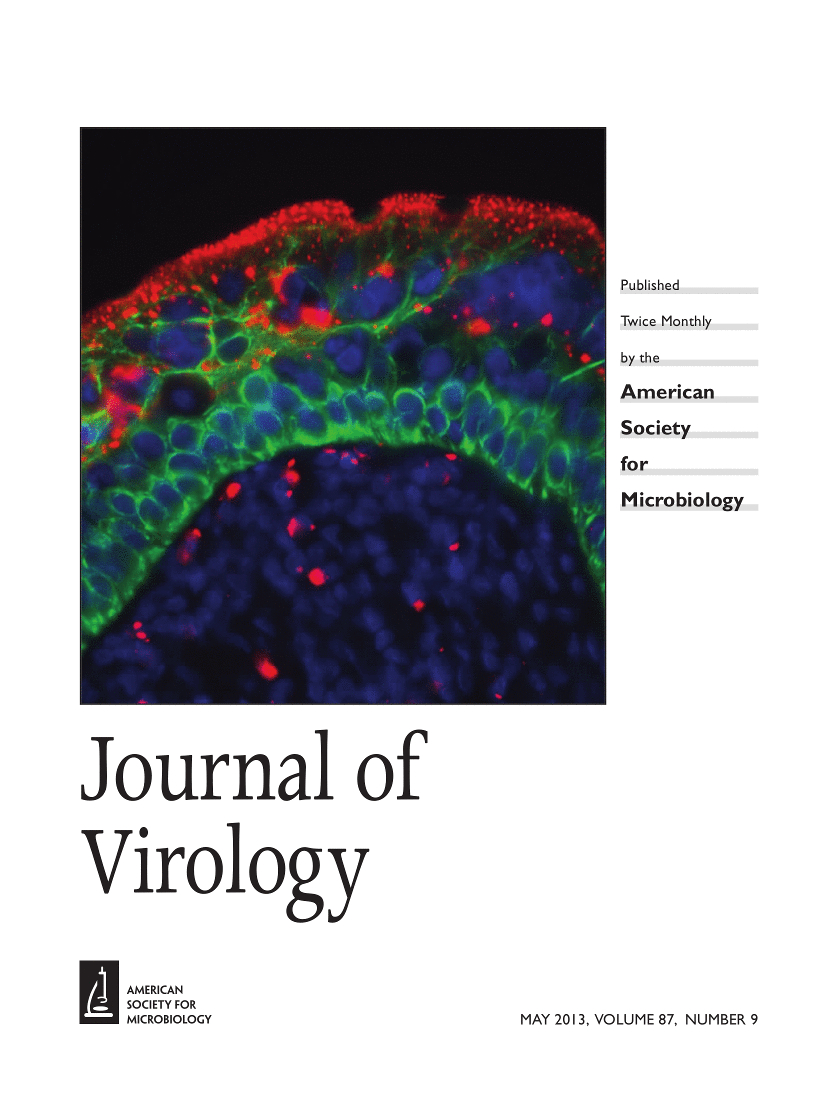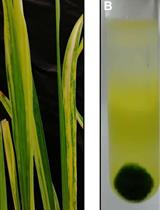- Submit a Protocol
- Receive Our Alerts
- Log in
- /
- Sign up
- My Bio Page
- Edit My Profile
- Change Password
- Log Out
- EN
- EN - English
- CN - 中文
- Protocols
- Articles and Issues
- For Authors
- About
- Become a Reviewer
- EN - English
- CN - 中文
- Home
- Protocols
- Articles and Issues
- For Authors
- About
- Become a Reviewer
Fitness Determinations in Vesicular Stomatitis Virus
Published: Vol 4, Iss 6, Mar 20, 2014 DOI: 10.21769/BioProtoc.1074 Views: 7916
Reviewed by: Anonymous reviewer(s)

Protocol Collections
Comprehensive collections of detailed, peer-reviewed protocols focusing on specific topics
Related protocols

Detachment Procedure of Bacteria from Atmospheric Particles for Flow-cytometry Counting
Carolina M. Araya [...] Isabel Reche
Jun 20, 2019 5447 Views

Assembly and Mutagenesis of Human Coronavirus OC43 Genomes in Yeast via Transformation-Associated Recombination
Brett A. Duguay and Craig McCormick
Aug 20, 2025 2617 Views
Abstract
Fitness is defined as the overall replicative ability. Testing whether a mutation (or combination of mutations) has an effect on fitness often relays on determining virus production as a surrogate measurement. However, viruses do not usually replicate in a void, and evolutionary speaking, it is key to determine replicative ability compared to other viruses, e.g. the relative fitness. John Holland developed a method for vesicular stomatitis virus based on the use of a neutral genetic marker that allows to distinguish two competitors and to measure accurately the relative ratio between the two during competition (Holland et al., 1991). The marker is a mutation in the external G glycoprotein that has no effect on the virus other than conferring resistance to a monoclonal antibody, I1. To measure fitness a marked test strain is mixed with a reference unmarked strain and the mixture is allowed to infect a cell monolayer. Ratios before and after competition are measured by plaque assay in the presence and absence of I1 antibody, and changes in ratio give the fitness value.
Materials and Reagents
- Test and reference VSV strains
Any neutral mutation that confers resistance to the monoclonal antibody used in the test is appropriate. For I1, which recognizes the A1 epitope of the G glycoprotein, mutation 3853 is our preferred choice. Mutation 3846 is not a good choice because it seems to be beneficial. Mutations indicate the nucleotide number of wild type Indiana serotype, Mudd-Summers strain. Mutant can be isolated by plaque-picking or by reverse genetics. Either way, the resulting population must be fully sequenced to ensure that no other mutations have been incorporated during the process. - Baby hamster kidney cells (BHK-21)
- 10x Trypsin/EDTA (Life Technologies, Gibco®, catalog number: 15400 )
- I1 Monoclonal antibody (I1Mab) hybridoma (ATCC, catalog number: CRL-2700 )
- Proteose peptone No. 3 (PP3) (BD DifcoTM, catalog number: 0 12207 ) (12 g/L in dH2O, autoclaved)
- Bovine Calf Serum (BCS) (Life Technologies, Gibco®, catalog number: 16170-078 )
- Fetal Bovine Serum (FBS) (Life Technologies, Gibco®, catalog number: 10437 )
- NaCl
- 10% CO2
- Agarose (Lonza, SeqplaqueTM GTGTM, catalog number: 50111 ) (40 g/L in dH2O, autoclaved)
- Glutamine (Life Technologies, InvitrogenTM, catalog number: 25030-081 )
- Minimal Essential Medium with Hanks salts (MEM-H) (Mediatech, Cellgro®, catalog number: 50-019-PB )
- Sodium bicarbonate (4.2 g/L in dH2O, autoclaved)
- Penicillin/streptomycin solution (Mediatech, Cellgro®, catalog number 30-004-Cl )
- Saline solution (see Recipes)
- Minimal Essential Medium with Earl’s salts (MEM-E) (Mediatech, Cellgro®, catalog number: 51-10-PB ) (see Recipes)
- Crystal violet solution (see Recipes)
Equipment
- 1.5 ml tubes
- T25 filtered-cap flasks (Cyto-One®, catalog number: CC7682-4825 )
- T-25 plug seal (if MEM-Hanks is used) (Cyto-One®, catalog number: CC7682-4325 )
- 5 ml and 25 ml pipettes
- Pasteur pipettes
- Type II biosafety hood
- 37 °C cell culture incubator
- Transilluminator (optional)
Procedure
- Make and titer I1 antibody; use enough concentration to produce full inhibition of wild type. Alternatively the antibody can be purchased from Kerafast https://www.kerafast.com/p-171-hybridoma-8g5f11-i1.aspx.
- On day 1 BHK-21 stock cells are washed twice with saline solution, trypsinized and ~0.8-1.0 x 105 cells are seeded in T25 flasks with MEM-E supplemented with 7% BCS and 0.06% PP3. The flasks are gassed for 2 sec with 10% CO2 using a plugged Pasteur pipette. Caps are locked.
- The cells are incubated for 24 h to produce monolayers 90% confluent.
- On day 2 virus mixtures are prepared. If the test virus is expected to be low fitness, the test: reference ratio should be close to 1:1. If the test virus is expected to be neutral of high fitness, ratio should be 10:1 or higher. The final viral concentration should be 106 PFU/ml (virus stocks should be titrated in advance).
Note: A number of other neutral markers can be used for these assays. Any neutral single-nucleotide substitution may be monitored by qRT-PCR. Some nucleotide substitutions can be engineered to create or destroy restriction sites that can be identified in agarose gels and quantified by densitometry. - Aspire growth medium in a T-25 flask using a Pasteur pipettedand use 200 μl of virus mixture to infect a monolayer. Incubate 10 min at room temperature (RT) and 40 min at 37 °C. Add 5 ml of MEM-E + FBS. This is the competition passage.
Note: This will result in the determination of fitness in BHK-21 cells under the incubation conditions specified here. Virus fitness can be determined under other kind of conditions of interest (different cell types, temperatures, presence/absence of antiviral molecules, etc) by changing the conditions of this passage. The rest of the procedure remains the same after adjusting for dilutions so one can count 20-200 plaques/flask. - Dilute a sample of the virus mixture to 1,000-fold and infect 3 BHK-21 monolayers with 200 μl to carry out plaque assays in the absence of I1Mab. This will produce approximately 200 plaques. Incubate 10 min at room temperature (RT) and 40 min at 37 °C. Melt agarose solution and add to prewarmed MEM-E+BCS to a final concentration of 0.2%. Add 5 ml to each flask.
- Infect 3 BHK-21 monolayers with 200 μl of the appropriate dilution to carry out plaque assay in the presence of I1Mab. If ratios are close to 1:1, 1,000-fold dilution a good choice. If there is excess of 10:1 or more reference virus, a 100-fold dilution should produce the desired results. Do not neutralize the mixture with I1Mab, as it will result in incorrect data due to phenotypic mixing and hiding (Valverde and Ortin, 1989; Holland et al.,1989). Incubate 10 min at room temperature (RT) and 40 min at 37 °C. Prewarm a mixture of MEM-E + BCS and I1Mab at enough concentration to achieve complete neutralization of wild type, add agarose to a final concentration of 0.2%, and add mixture to flasks.
Note: I1Mab needs to be titrated in advance. Different batches, particularly if produce in the laboratory from the hybridoma, may differ greatly in their final I1 activity. - Incubate competition passage and plaque assays for 24 h at 37 °C.
- Develop all plaque assays. Just let the overlay slide out and add 2-3 ml of crystal violet solution. Wait for 5 min at RT and rinse with tap water.
Note: Because of the low agarose concentration there is no need to fix the cells. - Count plaques and calculate initial ration (P0): (total virus – I1-resistant virus)/I1-resistant virus. The transilluminator is helpful for plaque counting.
- Take the yield from the competition passage yield and carry out triplicate plaque assays in the presence and absence of I1Mab as described (except that dilutions will need to be adjusted).
- Calculate the ratio after competition (P1) as described in step 10.
- Fitness is calculated as P1/P0.
- To increase the accuracy of the determination and increase the statistical power for subsequent analyses.
- If fitness values are closed to neutrality and the changes in ratio are small, use the yield of the first competition passage to carry out a second competition passage as described in step 5 and continue the process for up to 6-7 passages. Calculate fitness as the antilogarithm of the slope of log-ratio changes.
- If fitness values are very large or very small, carry out multiple independent competitions.

Figure 1. Determinations of relative fitness. A test virus (white particles) is mixed with a reference virus (grey particles) and the mixture is used to infect BHK-21 cells. The viruses will compete during replication, and the virus that is best adapted will produce a higher relative number of progeny virions. When compared to a reference, strains whose relative numbers increase are high fitness; strains whose relative numbers don’t change are neutral; strains whose relative numbers decrease are low fitness.
- If fitness values are closed to neutrality and the changes in ratio are small, use the yield of the first competition passage to carry out a second competition passage as described in step 5 and continue the process for up to 6-7 passages. Calculate fitness as the antilogarithm of the slope of log-ratio changes.
Recipes
- Saline solution
Add 7 g of NaCl to dH2O to 1,000 ml
Autoclave 20 min
Stored at RT - MEM-E
Mix powder with 9.55 L of dH2O
Distribute 0.955 L in each of 10 1-L bottle and autoclave
Let cool and add to each bottle- 25 ml of 4.2% bicarbonate
- 70 ml of serum (FEB or BCS)
- 10 ml of penicillin/streptomycin mixture
- 10 ml glutamine (diluted 1:10 from purchased stock)
- 5 ml of 12% PP3
- Making medium is worth it if there is a large volume of cell culture performed in the laboratory. Ready-to-use MEM-E can also be purchased from several companies.
- MEM with Hanks salts (MEM-H) is also a good choice and only requires that at the time that cells are split each flask is gassed for 2-3 sec with 5-10% CO2 (in N2/O2). The advantage is that there is no need for continuous supply of CO2, so any 37 °C incubator can be used. The medium is prepared similarly, but all components except serum and PP3 are mixed together and filtered before aliquoting. The powder has glutamine, so it does not need to be added.
- 25 ml of 4.2% bicarbonate
- Crystal violet solution
Mix 750 ml H2O, 250 ml Ethanol and 5 g crystal violet
Stir until dissolved and stored at RT
Acknowledgments
This protocol was originally published in Holland et al. (1991).
References
- Holland, J. J., de la Torre, J. C., Clarke, D. K. and Duarte, E. (1991). Quantitation of relative fitness and great adaptability of clonal populations of RNA viruses. J Virol 65(6): 2960-2967.
- Holland, J. J., de la Torre, J. C., Steinhauer, D. A., Clarke, D., Duarte, E. and Domingo, E. (1989). Virus mutation frequencies can be greatly underestimated by monoclonal antibody neutralization of virions. J Virol 63(12): 5030-5036.
- Valcarcel, J. and Ortin, J. (1989). Phenotypic hiding: the carryover of mutations in RNA viruses as shown by detection of mar mutants in influenza virus. J Virol 63(9): 4107-4109.
Article Information
Copyright
© 2014 The Authors; exclusive licensee Bio-protocol LLC.
How to cite
Novella, I. S. (2014). Fitness Determinations in Vesicular Stomatitis Virus. Bio-protocol 4(6): e1074. DOI: 10.21769/BioProtoc.1074.
Category
Microbiology > Microbial cell biology > Cell isolation and culture
Microbiology > Microbial genetics > Mutagenesis
Microbiology > Microbial genetics > RNA
Do you have any questions about this protocol?
Post your question to gather feedback from the community. We will also invite the authors of this article to respond.
Tips for asking effective questions
+ Description
Write a detailed description. Include all information that will help others answer your question including experimental processes, conditions, and relevant images.
Share
Bluesky
X
Copy link










